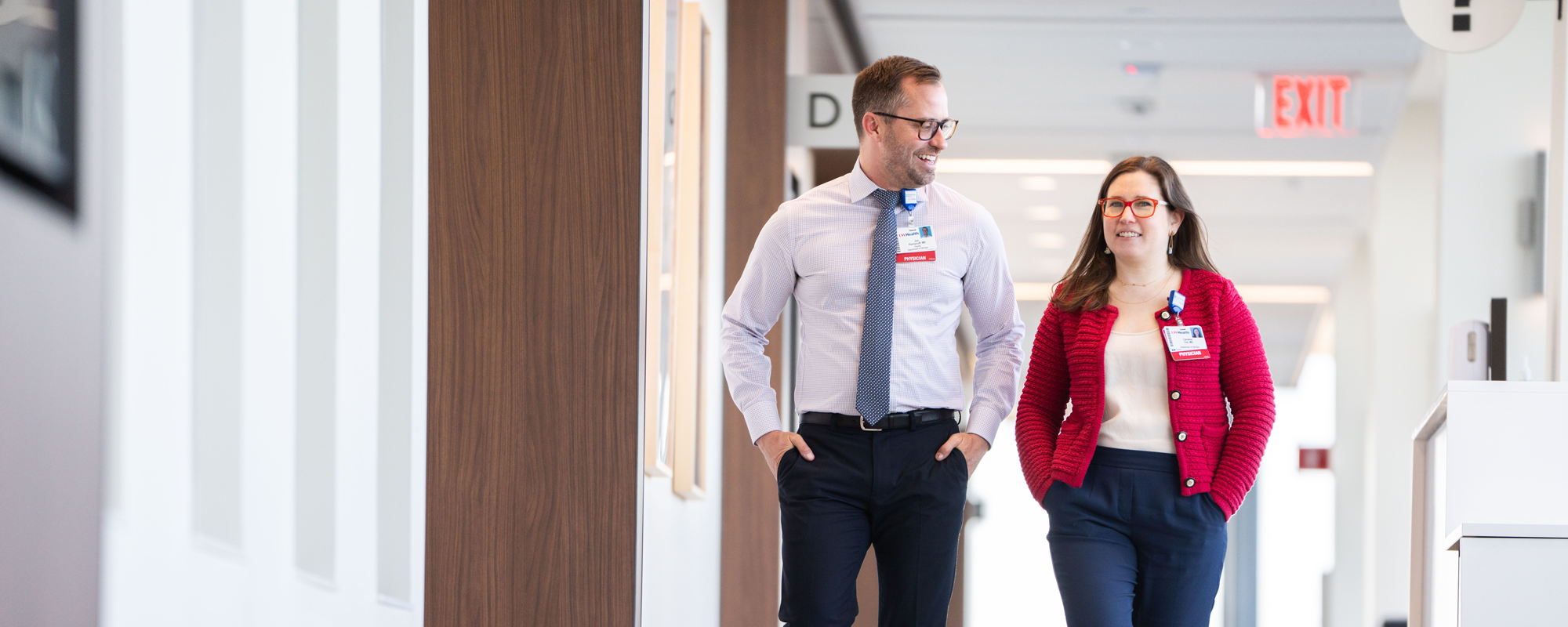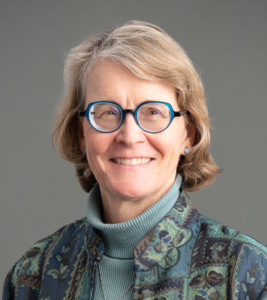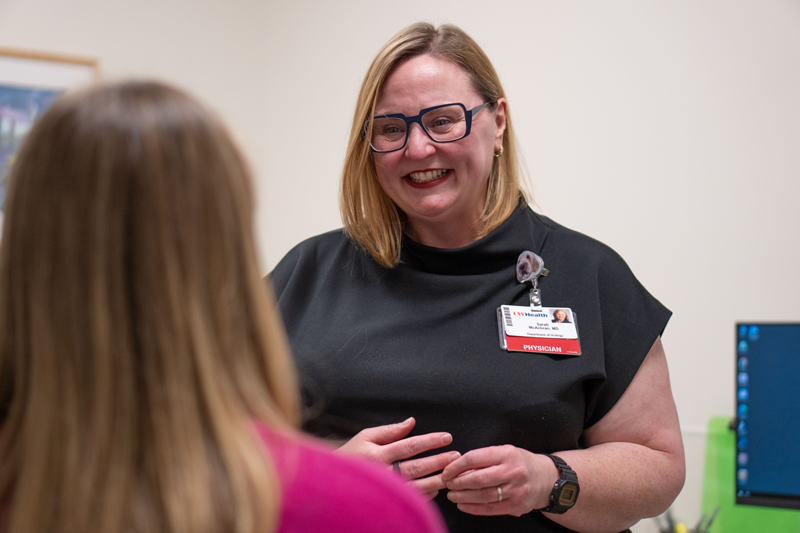Integrated Specialty Care for Women

Pelvic floor disorders are a common issue for women. Conditions like pelvic organ prolapse, urinary and fecal incontinence, fibroids, pelvic pain, and sexual dysfunction are becoming more prevalent as the U.S. population ages.
In 2022, researchers in the University of Wisconsin School of Medicine and Public Health (SMPH) Department of Obstetrics and Gynecology published a study in the journal Urogynecology that provided an updated estimate for rates of urinary incontinence in the United States. Their study found that more than 78 million adult women in this country experience some degree of urinary incontinence; that is around 60 percent of women in the United States.
“Pelvic floor disorders disproportionately affect older women,” says Sarah McAchran, MD, associate professor, SMPH Department of Urology. “Even though what we treat generally is not life-threatening, it has huge quality-of-life implications and, untreated, is connected to anxiety, depression, and other medical problems.”
To help meet the growing need for urogynecologic care, leaders at SMPH and UW Health worked together over several years to develop the distinctive UW Health Integrated Specialty Care for Women (ISCW). In November 2024, the program opened its doors to patient appointments in the new UW Health Eastpark Medical Center in Madison.
Identifying Care Gaps
“In our planning, we focused on making ISCW very patient-centric,” says Department of Obstetrics and Gynecology Chair Ellen Hartenbach, MD. “UW Health put a lot of resources into learning what patients need and want, and designed a clinic that can really deliver on that.”

To make sure the services would meet the needs and preferences of women, the team conducted in-depth interviews with a diverse group of patients who have at least one urogynecologic issue and receive care at UW Health or elsewhere. Through these interviews, the team sought to understand gaps and obstacles people encounter when seeking urogynecologic care.
Foremost, the feedback revealed a need for more awareness about pelvic floor conditions and proactive conversations with care teams. Though these conditions are very common, some patients and providers can be hesitant to talk about them.
“There’s still a lot of taboo around pelvic floor disorders, sexual health, all these conditions,” says Lisa Harlow, MS, program director, ISCW. “Sometimes women have been told that these issues are an inevitable part of aging, or they feel embarrassed and wait years to ask for help. Hearing this from our focus groups was eye-opening. These conditions can significantly limit people’s lives, but they often are uncomfortable bringing them up.”
Patients’ feedback helped inform all aspects of the program, from the services that are included to the ways information is shared with current and prospective patients. But getting people in the door is only the first step. Patient interviews also made it clear that people need more support as they move through treatment pathways that can be quite complex. For example, the treatment plan for a patient with a common condition like pelvic organ prolapse — when one or more pelvic organs drop from their position, creating a bulge or herniation in the vagina — may include care from a urogynecologist, gastroenterologist, physical therapist, and sex therapist.
“We talk about navigating the spiral, this idea that patients come in and have to work their way through our system to get the care they need,” says McAchran. “Every twist or turn is a spot where we might lose them. I remember a patient who came to me with some complicated issues. She was referred through multiple other specialties before ending up back in my clinic. I wanted to make sure my patients did not experience something like that ever again.”
A Multidisciplinary Approach
Because comprehensive management of pelvic floor disorders requires expertise from multiple specialties, coordinating that care in a centralized, accessible location is key to improving the patient experience. ISCW brings together physicians, advanced practice providers, and other clinicians from obstetrics and gynecology, urology, colorectal surgery, gastroenterology, behavioral health, and physical therapy to offer seamless care for a variety of concerns.

“The processes and pathways through this clinic were designed with patients in mind regarding what would make the most sense for them,” says McAchran. “We’re trying to make departmental silos matter a little bit less, especially where they don’t necessarily serve our patients.”

According to Stephen Y. Nakada, MD, FACS, FRCS, the David T. Uehling Chair and Professor of Urology, “It is integral and powerful that the Department of Urology works alongside the other departments in the ISCW to provide optimal care for the widest variety of conditions, from the most common to the most complex.”
When patients are connected to the ISCW, they could be matched for their intake appointment with a physician or advanced practice provider from the Department of Obstetrics and Gynecology or Department of Urology — both of which include fellowship-trained urogynecologists. This approach offers access for more patients to utilize the program.
“Then we can guide the follow-up to take better advantage of our multidisciplinary resources,” says McAchran. “We think about, can we bring patients back on a day when they can see multiple specialists? Can we schedule their physical therapy appointments on the same day?”
Beyond improving scheduling efficiency to help patients get the most out of each visit, ISCW opens opportunities for spontaneous communication and collaboration among providers.
“Perspectives from different areas of expertise give our patients more options,” says Caroline Cox, MD, urogynecologist and assistant professor in the Department of Obstetrics and Gynecology. “If I have a question or an unusual finding, I can step out and talk to the urologist or bring them in to see what I am seeing. The patient gets that extra insight right away, instead of waiting for the physicians to exchange messages or having to come back for another visit.”

Physical therapists and behavioral health providers who specialize in sex therapy are also under the umbrella of ISCW, making it easier for patients to connect with supportive services that can make a big difference in their care. Pelvic floor physical therapy is a key component in many treatment plans for urogynecologic issues; research from the ISCW team found that people were more likely to engage with physical therapy if they had a consultation with a physical therapist on the same day as an appointment with a urogynecologist.
Many ISCW patients can benefit from sexual health counseling, as some pelvic floor conditions make sex painful or difficult. Integrating sexual health services into the ISCW program can improve adherence to treatment plans, says Madelyn Esposito, LPC, program manager of the Sexual Health Clinic.
“Programs like this can improve patient outcomes. Just asking about sex, making space for patients to talk about their sexual health concerns, can build so much trust with a provider,” says Esposito. “Many of my clients won’t take medications if they are worried about sexual side effects, so even on the logistical side, people are more inclined to pursue treatment if they can talk about the impacts on their sex life and know they have extra support from their health care team.”
Mission-based Training
The SMPH Department of Obstetrics and Gynecology operates with the mission of improving the reproductive health and well-being of people in Wisconsin and beyond through education, research, clinical care, and advocacy. The department’s and the school’s research and educational missions are fully woven into ISCW.
UW Health offers the only Urogynecology and Reconstructive Pelvic Surgery (URPS) Fellowship in Wisconsin; physicians can apply for this fellowship following residency training in either obstetrics and gynecology or urology. Since recruiting the first fellow in 2021, the URPS Fellowship Program has gotten increasingly competitive, with more than 70 applications for one spot in 2025, according to Jon Pennycuff, MD, MSPH, assistant professor, Department of Obstetrics and Gynecology.
“We are preparing the next generation of pelvic floor doctors, and ISCW is providing an incredibly robust educational experience,” says Pennycuff. “Because gynecology, urology, and colorectal surgery are all integrated within this fellowship, our trainees receive a holistic, patient-centered view of urogynecologic care. Our fellows take that model of care with them to patients in our state and region after they graduate.”
The multidisciplinary nature of ISCW also has the potential to expand participation in a wide variety of clinical trials and research projects. Before the launch of ISCW, patients were seen in either obstetrics and gynecology clinics or urology clinics, but not both, and opportunities to participate in clinical research were not always well-communicated across departments. Investigators in ISCW also have been chosen to lead local arms of national studies looking at innovative medical devices to improve pelvic floor symptoms. With the combined clinic, patients have more opportunities to participate in clinical research, if they desire.
“We are getting these opportunities to participate in national research in large part because of our emphasis on Integrated Specialty Care for Women,” says Pennycuff. “This clinic has been so helpful in boosting UW–Madison’s reputation as a place that’s innovating and making a mark in pelvic care.”
Plans for Growth
Just a few months into its operation, leaders agree that directing institutional efforts toward this multidisciplinary clinic is making a difference. Clinic volumes have grown at a rate of 49 percent over the last six years, exceeding the 10-year growth projection rate by 15 percent.
Additional areas of expansion are on the horizon, too. In April 2025, Babak Vakili, MD, joined UW Health as the first medical director of ISCW, stepping into a role designed to help the program maintain high-quality clinical operations; seamlessly integrate educational and research efforts; and develop effective plans for growth. He brings extensive leadership experience from ChristianaCare in Delaware, where he developed specialty clinics in pelvic pain and sexual health, mentored gynecologic surgeons, and more.
Later in 2025, ISCW will expand the available services to include the Minimally Invasive Gynecologic Surgery (MIGS) Program with a focus on endometriosis and fibroids. The MIGS Program will offer holistic treatment options for these conditions, connecting patients to resources in pain management, radiology, sexual health, and more to help them choose treatment pathways that best align with their goals.
As ISCW faculty and staff look ahead to an exciting future, the team will keep the focus on the missions of SMPH and UW Health.
“We’re rooted in providing exceptional patient care,” says Pennycuff, “and we’re always looking toward how we can innovate, move medicine forward, and continue to advance urogynecology.”
A Healing Space
Efficiency was not the only design goal incorporated into the planning of Integrated Specialty Care for Women (ISCW). The clinic is on the seventh floor of Eastpark Medical Center, which was the largest medical center built in the United States in 2024. By giving ISCW a prime space, UW Health leaders hoped to bring pelvic health into the light.

“Eastpark had a biophilic design focus, connecting the building to nature and creating a healing environment,” says Teresa Neely, UW Health vice president, regional chief operating officer. “The design allows natural light into areas where our care teams are working, and the public spaces within the building overlook a beautiful courtyard. We wanted the clinic design to cultivate an inviting environment where our patients can feel confident and comfortable talking about these sensitive issues in our space.”

